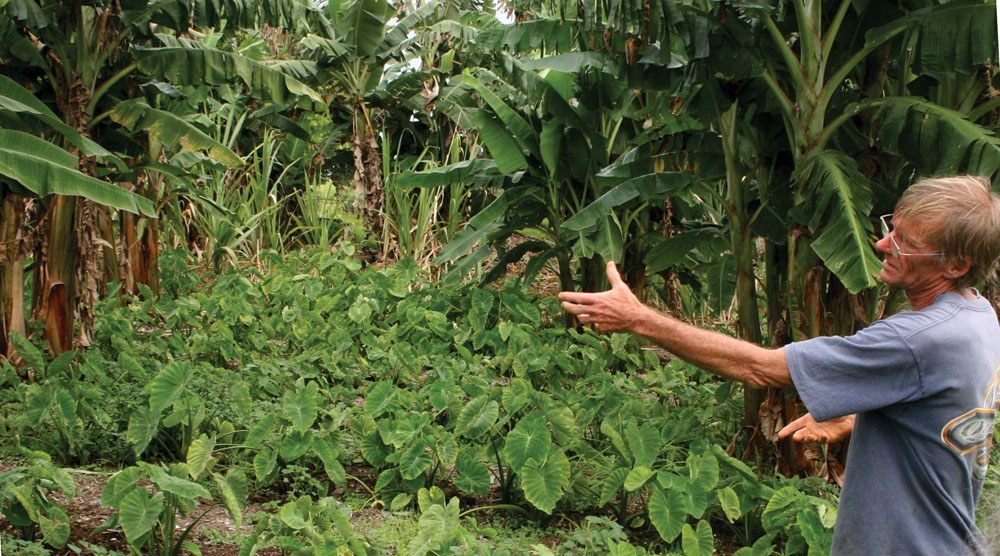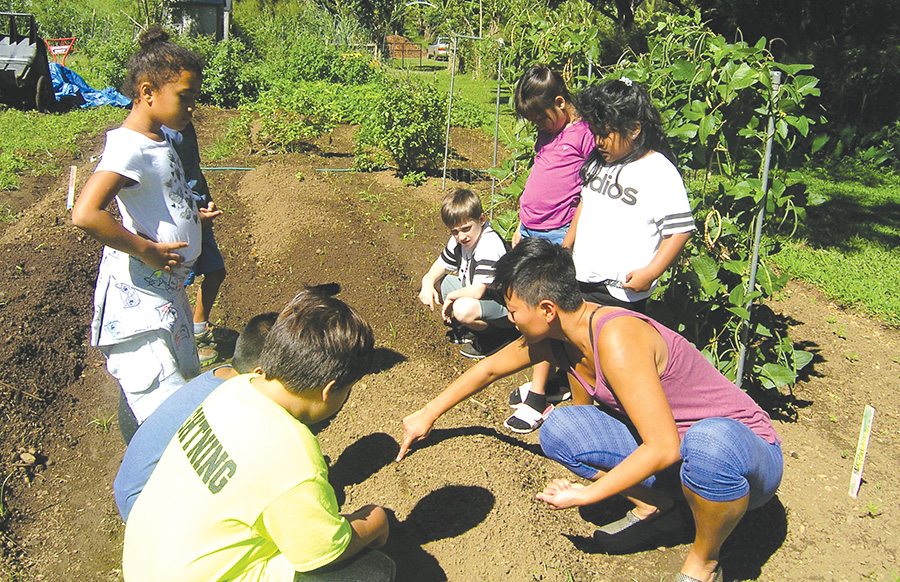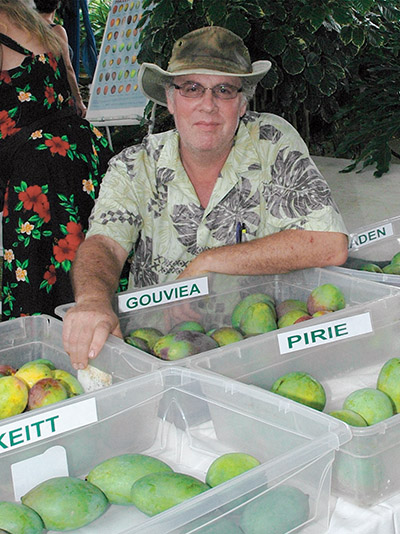
Beyond Organic: Natural Farming

By Noel Morata
A new trend—natural farming—is being embraced by backyard gardeners and farmers here on Hawai‘i Island. These methods have been shown to enhance growing organically, focusing on long-term sustainability and using local, raw products and indigenous, green materials to provide bountiful, organic crops.
One of the early adopters of natural farming is Onomea Organics, John Cavarly’s farm in Onomea. “I have recently embraced natural farming along with my organic farming and this has produced amazing results in a very short timeframe,” Cavarly says. He has been an organic farmer for more than 30 years and just recently started the natural farming process at his farm, which currently produces a variety of dry land taro, cassava, bananas, papaya and white pineapples. Even though John has been growing plants organically, he has already seen a marked improvement to his operations, productivity and, most important, the fertility of his soil.
Natural farming uses farming techniques before western and conventional farming methods became the de-facto standard. In simple terms, farmers use only what nature provides to farm their properties. They gather indigenous, local and other raw materials to create nutrients to fertilize their crops. This might include crushed egg shells, cow bones or even green materials like bamboo leaves, mugwort, dropwort or pig weed (also known as portacula). They use natural nutrients to control pests and to enrich their soils without excessive manipulation of the land. This “return to nature” farming is paying off with more bountiful crops, decreasing farming expenses and an increasing awareness of stewarding farms in a better way.

A new non-profit group called Cho Global Natural Farming USA has been established in Hawai‘i to spread the knowledge of natural farming techniques. It is planning extensive farming seminars on all the islands. An initial program sponsored by Hawai‘i County and various local organizations attracted more than 300 participants from all over the Hawaiian Islands. This gathering learned new, innovative natural farming methods from Master Han Kyu Cho, founder of the Cho Global Natural Farming Institute. This Korean organization has trained many large-scale farming communities and is now expanding into other countries.
The main goal of natural farming is to create fertile soil by developing an enriched growing environment that supports indigenous micro-organisms (IMO’s) and worms. These live components are the keys to increasing soil fertility, nutrient development and natural tilling of the soil. The farmer creates a welcoming environment for the organisms by creating natural nutrients for fertilization and natural pesticide control.
Master Cho showed different approaches to natural farming that replace expensive fertilizers, pesticides, equipment and labor,. He explained how using natural farming techniques and materials actually reduced costs, increased production and created enriched and healthy environments for the soil, along with spiritually connecting farmers back to their environments. One illustration cited was excessive manipulation of the soil through tilling, which he countered was actually detrimental to the soil’s environment. Apparently, heavy tilling destroys the majority of healthy micro-organisms that are prevalent just below the surface of the soil. Instead of heavy tilling, the farmers were told to make shallow holes to sow or transplant their seedlings.
Instead of excessive weeding and efforts to eradicate weeds, the growers were advised to just cut down most of the weeds and use them as a preventative layer. An initial “mulch crop,” such as corn, can be used as mulch, weed prevention cover and nutrient development for the soil.
Natural farming concepts are often the exact opposite of what is generally accepted today. In fact, there were many conventional farming concepts that were challenged during this seminar. Overall, a majority of the farmers participating took away new ideas that they may take with them to the fields, even though many will likely find it will take time to incorporate all of this new thinking into their practices.
On Cavarly’s farm, six flats of poha berries and parsley were started with indigenous micro organisms as an initial test batch and, within two weeks, John says excitedly, “I noticed incredible growth and solid root systems—at a much faster growth rate than normal. I also did a test batch of beans in a trenched area of extremely poor soil, with no nutrients and worms,” he added. “After treating the soil with IMOs, the beans were growing like crazy in a very short time—starting flowers and developing pods.” After digging into the soil, John noted a huge difference in the soil culture with worms popping up everywhere. He also mentioned that the new convergence of worms resulted in better nutrient development, including calcium deposits which are a major requirement for the soil. This has been a major cost savings for him in both minimizing his reliance on organic fertilizers and in reducing the need for pesticides.
Taro patches throughout Hawai‘i Island have been affected with the Dacheens Mosaic virus, which creates malformations in taro leaves and decreases overall production. “After treating my taro beds with IMO,” Cavarly says, “the virus has been eliminated from my taro patch and my plants are all very healthy and green.” He also planted a patch of taro before a severe drought hit this side of the island and, pointing to the plants, adds, “Those taro are looking very healthy even though they received no rainfall for over a month’s timeframe.” John has been further experimenting to see what additional effects might be gained through various methodologies. He is constantly creating new beds with different complementary plants, experimenting with bio-char (charcoal) applications on various beds, and experimenting with different solutions and improvements.
This is only one farm that has initially started the natural farming process to treat extremely poor soil conditions that had no worm cultures and suffered various viruses on plants. Within a short growing cycle, positive results included more fertile soil, eradication of viruses and pests and increased plant growth and productivity.
Other natural farming concepts utilized include minimizing excessive weeding and efforts to eradicate weeds; growing an initial cover crop like corn, which is used primarily for mulch, a weed prevention cover and nutrient development for the soil. Another concept is shallow digging for starts and seed cultivation. Digging shallow creates a tougher environment for the plant and doesn’t disturb the soil’s composition and natural elements at the surface of the soil.
A monthly group forum has also been started to meet and share more information about natural farming techniques being used locally. ❖
For more information: www.localgarden.us/


